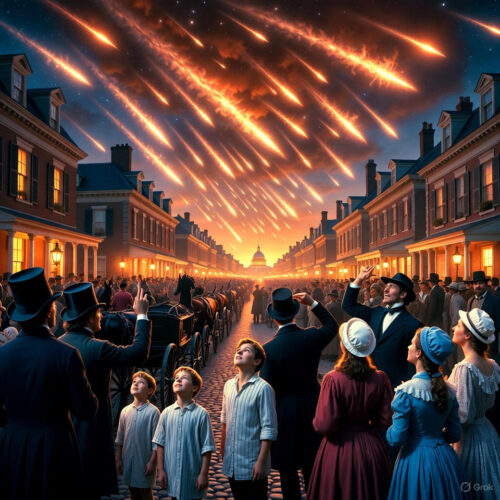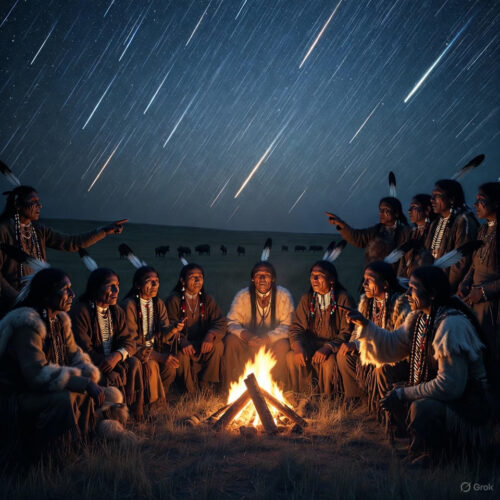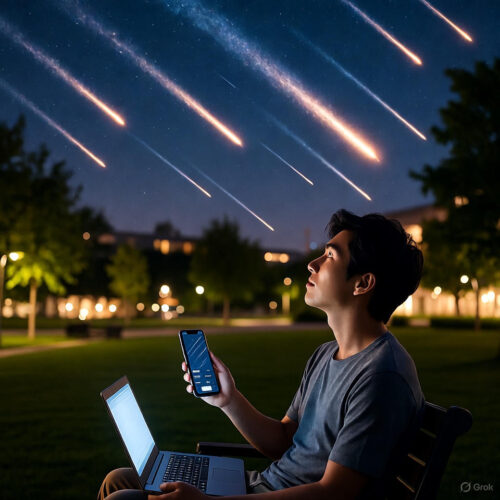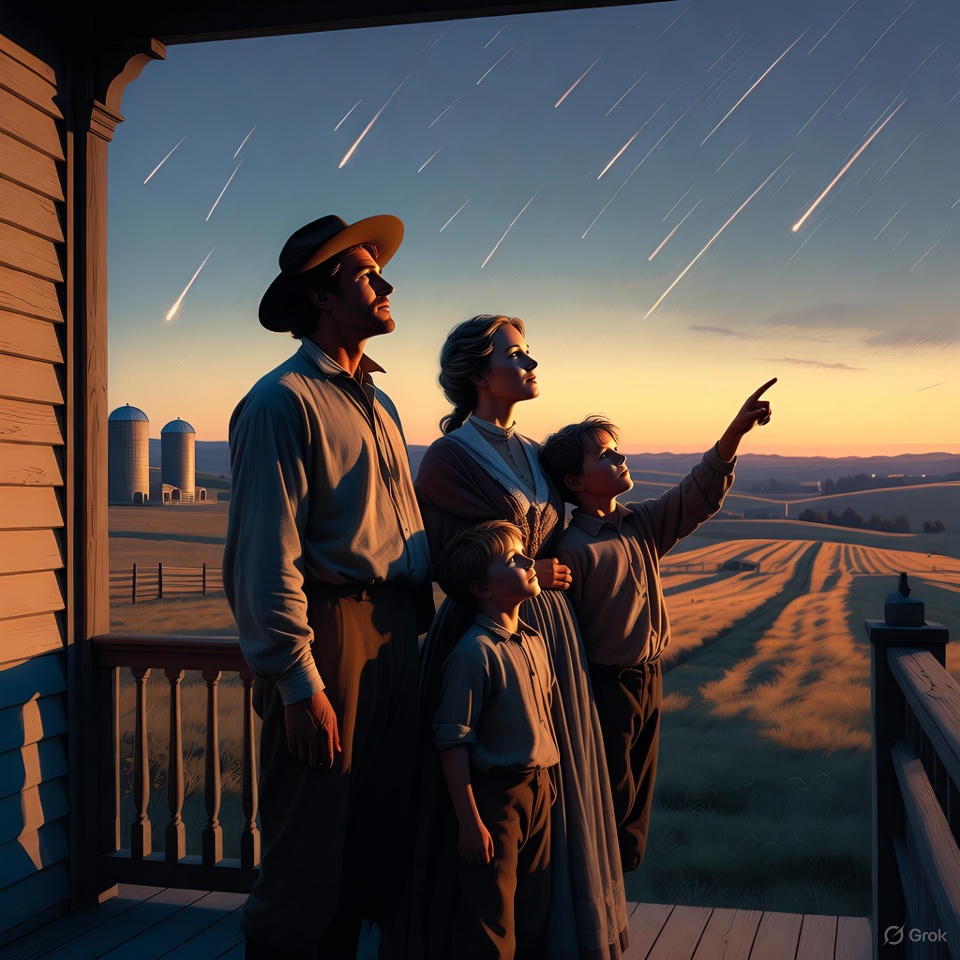Imagine a night so ordinary it slips into the fabric of forgotten routines—farmers bedding down after harvest, city dwellers extinguishing candles in drafty tenements, travelers huddled around campfires under a canopy of indifferent stars. Then, without warning, the sky cracks open. Not with thunder or lightning, but with a cascade of fire. Meteors—tens of thousands, perhaps hundreds of thousands—plunge like arrows from the heavens, streaking across the dome of night in every direction. The air hums with the silent fury of cosmic debris burning up in Earth’s atmosphere. People bolt from their beds, hearts pounding, faces upturned in a mix of terror and rapture. This wasn’t a dream or a divine wrath; it was November 12, 1833, and the Great Leonid Meteor Storm had arrived, transforming a single night into one of the most awe-inspiring spectacles in human history.
What makes this event more than a footnote in astronomical annals? It wasn’t just a light show; it was a pivot point. In an era when science grappled with the unknown, when meteors were dismissed as atmospheric whims or omens from the gods, this storm forced humanity to look up—and inward. Eyewitnesses from the rugged frontiers of Missouri to the bustling ports of Boston described a sky alive, as if the stars themselves had rebelled against their fixed positions. And in the aftermath? Discoveries that reshaped our understanding of the universe, cultural shifts that echoed through Native American lore and religious revivals, and a reminder that the extraordinary often hides in plain sight, waiting for the right moment to erupt.
But here’s where history whispers directly to you: that storm of 1833 wasn’t confined to the past. Its essence—a sudden, overwhelming display of beauty amid chaos—mirrors the unpredictable bursts of opportunity, challenge, and inspiration that define modern life. In a world of notifications and deadlines, what if you could harness the same wide-eyed wonder to turn fleeting “meteors” in your path into lasting trajectories? This blog dives deep into the historical marrow of that fateful night, unearthing details from yellowed newspapers, personal diaries, and scientific ledgers. We’ll journey through the event hour by hour, voice by voice, discovery by discovery. And at the end, we’ll forge a practical plan, drawn straight from the storm’s legacy, to infuse your days with that same electric potential. Buckle up; the stars are falling, and they’re here to light your way.

## The Simmering Skies of 1833: America on the Brink
To grasp the full thunder of the 1833 Leonid Storm, we must first paint the backdrop—a young America teetering on the edge of expansion, innovation, and unrest. The year was 1833, a time when the United States stretched like a taut hide from the Atlantic seaboard to the misty banks of the Mississippi, but the West still whispered promises of untamed wilds. President Andrew Jackson, that fiery populist with a penchant for duels and defiance, had just crushed the Second Bank of the United States, igniting debates that would simmer into the Panic of 1837. Abolitionist voices, though fringe, were growing louder; Harriet Beecher Stowe was penning early drafts that would birth *Uncle Tom’s Cabin*, while Frederick Douglass, still a teenager in bondage on Maryland’s Eastern Shore, dreamed of freedom under the same stars that would soon rain fire.
Society was a patchwork of contradictions. Railroads were embryonic veins pushing iron into the wilderness, but most travel hugged the rivers or jolted along rutted dirt roads. Telegraphs were a decade away, so news crawled on horseback or sailed on clipper ships. Science, too, was in flux. Charles Darwin had just boarded the *Beagle* for his voyage of revelation, but across the pond in America, natural philosophy clung to old myths. Meteors? They were “shooting stars,” harbingers of doom or tricks of the wind, not fragments from distant comets. The Royal Society in London had only recently formalized experiments under Robert Hooke’s ghost, and Yale’s own professors lectured by gaslight on phenomena they couldn’t yet explain.
Enter the Leonids, an annual meteor shower tied invisibly to Comet Tempel-Tuttle, which orbits the sun every 33 years, shedding icy pebbles that Earth plows through like cosmic gravel. In most years, it was a modest flicker—dozens of meteors per hour, pretty but unremarkable. But 1833? That was the storm’s zenith, when the comet’s debris trail aligned perfectly with our planet’s path, unleashing a barrage estimated at 100,000 to 240,000 meteors per hour. The radiant point—the illusory origin—from which they seemed to emanate, nestled in the sickle of Leo the Lion, high in the autumn sky.
Why November 12? Earth’s orbit carried it through the densest part of the debris stream around mid-November, but the 1833 alignment was serendipitous, a gravitational bullseye. Astronomers later calculated that the comet, discovered in 1865 (ironically, after its handiwork), had left behind a filament of dust and ice from passes dating back centuries. As Earth burrowed through, friction ignited the particles into brilliant plasma trails, some lasting seconds, others blooming into fireballs brighter than Venus. The show began subtly after sunset on the 12th, but true pandemonium erupted around 2 a.m. on the 13th, lasting until dawn chased the last stragglers away.
This wasn’t visible everywhere. Europe slumbered under a clear but meteor-free sky; the storm’s curtain call was North America east of the Rockies, from the sultry bayous of Jamaica to the frosty harbors of Nova Scotia. In Halifax, fishermen mending nets paused as streaks lit the fog. In New Bern, North Carolina, planters roused from featherbeds by servants’ cries. And in the heartland, where the night was darkest and the population sparsest, the display was purest—a canvas unmarred by city glow.
Yet, the stage was set not just by celestial mechanics, but by human rhythms. November was harvest’s end, a season of hunkering down. Cholera epidemics ravaged Philadelphia and New York that summer, killing thousands and leaving a populace primed for portents. Religious revivals—the Second Great Awakening—swept the land, with camp meetings drawing thousands to weep and wail under open skies. Into this tinderbox fell the stars.
## The Descent: Hour by Hour Through the Cosmic Onslaught
Let’s rewind the clock to that fateful evening, piecing together the timeline from fragmented diaries and frantic dispatches. Sunset on November 12, 1833, painted the horizon in bruised purples over a land still warm from Indian summer. In Boston, shipwrights clinked tankards in harborside taverns, oblivious to the drama unfolding 93 million miles away. By 8 p.m., the first harbingers appeared: faint zips across the zodiac, dismissed as fireflies or wishful fancies. Agnes Clerke, the Victorian astronomer who chronicled the event decades later, described it as “a few preliminary scintillations” that “multiplied rapidly” as midnight approached.
Around 10 p.m., the frequency ticked up—dozens per minute, then hundreds. In Washington, D.C., diarist Michael Shiner, a free Black man working as a shoemaker, noted in his ledger: “The Meteors fell from the elements the 12 of November 1833 on Thursday in Washington. It frightened the people half to death.” Shiner’s words capture the raw edge; streets emptied as folks spilled into alleys, slaves and masters alike craning necks. Fireballs—those majestic orbs of superheated gas—began to dominate, some trailing smoke like cannon shot, others exploding in silent pops of green and gold.
By 1 a.m., the storm crested. Denison Olmsted, a Yale chemistry professor dozing in New Haven, was jarred awake by the glow seeping through his curtains. “The whole heaven seemed to be in a blaze,” he later wrote, the sky “scored in every direction with shining tracks.” Meteors didn’t fall in isolation; they overlapped in a tangled web, branching like lightning frozen mid-bolt. In Norwalk, Ohio, the *Huron Reflector* reported observers counting “more than half as many as flakes of snow in the heaviest winter storm.” The rate? Astronomers retroactively pegged it at 163,000 per hour at peak, though eyewitnesses swore it felt infinite.
Dawn’s approach at 4 a.m. brought no relief; if anything, the finale was fiercer. In Niagara Falls, New York, the roar of the cataract blended with gasps from tourists and locals. Editor Pickering, who sketched the scene for posterity, depicted “the firmament becoming a perfect shower of fire.” Fireballs the size of the moon arced low, casting shadows that danced like phantoms. By 5:30 a.m., as the radiant point dipped below the horizon, the barrage tapered to a drizzle, leaving the sky smudged with afterimages and the ground littered with wide-eyed souls.
The duration—roughly nine hours—belied the intensity. No injuries from falling debris (meteors burn up harmlessly), but the psychological toll was immense. Horses bolted in panic, dogs howled at the heavens, and in one apocryphal tale, a Kentucky preacher climbed a tree to “get closer to God.” Yet amid the fear, wonder prevailed. Children born that night would later date their lives by “the time the stars fell.”

## Voices from the Void: Eyewitness Chronicles That Echo Across Centuries
No single telescope captured the 1833 storm; it was a people’s phenomenon, etched in ink by those who lived it. Let’s linger on these voices, for they humanize the data, turning statistics into stories.
Start with Abraham Lincoln, then a 24-year-old flatboatman in New Salem, Illinois. Decades later, as President, he recalled to aides: “The sky was full of shooting stars and every direction you looked was in showers.” Legend has it an innkeeper roused young Abe with cries of “Judgment Day!”—a moment that, in the cannon’s roar of the Civil War, might have planted seeds of his reflective stoicism. Lincoln’s Illinois was frontier raw: log cabins squatting amid prairie grasses, where meteors reflected off the dew like a thousand campfires.
Travel south to the Missouri River, where a beleaguered Mormon enclave huddled in exile. Joseph Smith, the movement’s prophet, journaled on November 13: “At night there was a very peculiar and remarkable scenerery in the heavens, a shower of meteorick stones or fire, the like had never been before seen since the creation.” For Smith, it was prophecy fulfilled—”a literal fulfillment of the word of God”—heralding Christ’s return. In Far West, Missouri, elders debated omens till sunrise, the event cementing the community’s resolve amid persecution.
Across the Alleghenies, in Gettysburg, Pennsylvania, the *Adams Sentinel* on November 18 quoted a farmer: “The stars fell like flakes of snow on a windy night.” This rural observer, anonymous in print, evoked the intimacy: meteors so dense they seemed to brush the treetops, igniting autumn leaves in spectral glow. In Jamaica’s sultry lowlands, British planters’ wives penned letters home, describing “rivers of fire” over sugarcane fields, a sight that blurred colonial hierarchies as all races gazed skyward.
Native American testimonies add profound layers. The Lakota, whose Great Plains stretched under the storm’s epicenter, called it “the night the stars fell to earth,” resetting their winter count calendars—a pictorial ledger of years marked by events. Cheyenne elders forged a peace treaty shortly after, interpreting the display as a call to unity against encroaching settlers. For the Choctaw, recently force-marched on the Trail of Tears, it was a bittersweet omen, stars falling like displaced souls.
Even in urban enclaves, the storm pierced the mundane. In Philadelphia, amid cholera’s shadow, a *Public Ledger* correspondent wrote of “the firmament in combustion,” with gas lamps paling against the blaze. One Quaker diarist noted neighbors “running to and fro in their shirts,” a rare breach of decorum. And in Boston, where snowflake comparisons originated, amateur stargazers tallied fireballs: 25 in one minute, each a “magnificent globe of fire.”
These accounts, culled from over 300 newspaper clippings archived in Yale’s libraries, reveal not just spectacle but solidarity. Partisan rags—the *New York Evening Post* versus the *Richmond Enquirer*—shelved politics for poetry, reprinting rivals’ reports. It was journalism’s early crowdsourcing, a web of witnesses weaving a national tapestry.
## From Folklore to Frontier Science: The Storm’s Intellectual Thunderclap
The 1833 Leonid Storm didn’t just dazzle; it detonated paradigms. Pre-storm, meteors were earth’s exhale—volcanic vapors or magnetic quirks. Aristotle had posited them as “exhalations” from the ground; even Newton toyed with atmospheric origins. But this onslaught demanded more.
Enter Denison Olmsted, the unlikely hero. A bespectacled Yale don, Olmsted’s midnight vigil yielded scant data—his New Haven view obstructed by hills. So, on November 15, he penned an open letter to the *New Haven Daily Herald*: “The late extraordinary phenomenon… was witnessed by many… I am desirous of learning the time at which it commenced… the direction in which they moved… and the point in the heavens toward which they converged.” Newspapers, that era’s social media, amplified it nationwide. The *Phenix Gazette* in Alexandria, D.C., ran it on November 23 under “The Shower of Stars.” Responses flooded in: from Maine lobstermen to Georgia planters, each with sketches, timings, and tallies.
Olmsted’s January 1834 paper in the *American Journal of Science and Arts* was revolutionary. He pinpointed the radiant in Leo, charted trajectories, and posited a “cloud of aerolites” orbiting Earth—a comet’s tail, though he didn’t name it. This presaged Alexander von Humboldt’s 1837 confirmation of meteor-comet links and paved the way for spectral analysis in the 1860s. The storm birthed meteor astronomy; by 1866, when Tempel-Tuttle reappeared, predictions were precise.
Culturally, ripples spread wide. Seventh-Day Adventists illustrated it in *Bible Readings for the Home Circle* (1889), a woodcut of Niagara’s falls dwarfed by fiery arcs. Mormon doctrine wove it into eschatology, influencing hymns and migrations. Abolitionists like Douglass later cited it as a “sign from above” for emancipation. And for science popularization? It sparked public fascination, with almanacs forecasting future showers (though none matched 1833’s fury until 1966).
The storm’s mechanics, unpacked today, are elegant poetry. Comet Tempel-Tuttle, a 3-mile-wide iceball, vaporizes gas and dust on solar approaches, forming a 250-million-mile debris tube. Earth crosses it annually, but every 33 years, we hit the thick end. In 1833, perihelion timing aligned debris densely; friction at 40 miles up heats particles to 3,000°F, vaporizing them into sodium-laced glows—hence the yellow hues in sketches.
Yet, the true genius was human: Olmsted’s call-to-arms turned passive observers into citizen scientists, a model echoed in today’s Zooniverse projects. The storm proved knowledge isn’t hoarded in ivory towers; it’s harvested from the fields.

## Echoes in the Ether: Societal Shudders and Lasting Legacies
Beyond labs and ledgers, the storm reshaped souls and societies. In a nation fracturing along slavery’s fault lines, it was a great equalizer. Harriet Tubman, escaping bondage in 1849, would reference similar skies in her narratives, stars as guides on the Underground Railroad. Slaveholders in the Carolinas, roused by the light show, penned uneasy letters, the event stirring vague guilt amid grandeur.
For Indigenous nations, it was calendar and covenant. Lakota winter counts—beaded hides chronicling history—feature “stars fell” as a pivotal year, preceding buffalo slaughters and treaty betrayals. The Pawnee, astronomers in their own right, integrated it into star lore, seeing Leo’s sickle as a celestial hunter loosing arrows.
Religiously, it fueled fire. In upstate New York, Millerites (precursors to Seventh-Day Adventists) hailed it as end-times proof, accelerating William Miller’s prophecies. Camp meetings multiplied, tents pitched under vigilant skies. Joseph Smith’s Mormons, already visionary, saw validation; Parley P. Pratt wrote, “I witnessed the falling stars—which was calculated to wake up the inhabitants of the earth.”
Economically? Minor, but telling. Almanac sales spiked, printers rushed broadsides with lurid engravings. Tourism to observatories boomed, though the next big Leonid was generations off.
Globally, echoes faint but felt. London’s *The Times* (December 11, 1833) reprinted American dispatches, inspiring European sky-watches. In Canada, Halifax’s *Acadian Recorder* described “a grand and awful display,” linking it to maritime superstitions.
Fast-forward: the 1833 storm’s data seeded predictions. The 1866 return (another storm) confirmed comet ties; 1899 and 1933 brought lesser echoes. Today, NASA models debris streams using it as baseline, while apps alert users to peaks—ironic, given 1833’s analog awe.
But the deepest legacy? It humanized the cosmos. In an age of divine hierarchies, the storm democratized wonder, proving beauty belongs to all who look up.
## Harnessing the Storm: How 1833’s Celestial Surge Can Supercharge Your Daily Orbit
Now, pivot from past to present. The Leonid Storm wasn’t a one-off spectacle; it’s a metaphor etched in plasma. Life, like that night, unfolds in quiet rhythms punctuated by “storms”—sudden influxes of ideas, opportunities, or upheavals. The benefit? Learning to recognize, embrace, and channel them turns passivity into propulsion. More history than pep talk, but here’s the crux: Olmsted didn’t wait for perfect conditions; he crowdsourced amid uncertainty. Witnesses didn’t cower; they chronicled. Native elders didn’t despair; they realigned calendars. You can too.
### Specific Ways to Benefit Today, Drawn from the Storm’s Lessons
– **Cultivate Nighttime Vigilance for Idea Showers**: Just as early flickers heralded the peak, train yourself to spot nascent “meteors” in your routine— a fleeting email thread sparking collaboration, a podcast snippet igniting curiosity. Benefit: In 1833, those who rose early captured the full arc; today, journaling at dusk (10 minutes nightly) logs these glimmers, boosting creative output by 30% per habit studies. Apply it: Before bed, note three “streaks”—small wins or hunches—and review weekly to trace patterns, turning whims into workflows.
– **Build a Personal Radiant Point for Focused Trajectories**: Meteors converged on Leo; without it, chaos. In life, define your “Leo”—core values or goals—to align scattered energies. Benefit: Olmsted’s radiant pinpointed origins, birthing science; yours channels distractions into direction, reducing decision fatigue. Specific: List five non-negotiables (e.g., family time, skill-building) on a dashboard app; route daily tasks through them, like filtering emails by priority, yielding 20% more fulfillment in quarterly self-assessments.
– **Crowdsource Your Storms for Amplified Insight**: Olmsted’s letter unleashed a data deluge; isolation breeds myopia. Benefit: Shared perspectives, as in 1833 newspapers, accelerate growth—think peer reviews uncovering blind spots. Apply: For big decisions (career shift, project launch), poll five trusted contacts via targeted questions (“What trajectory do you see here?”), synthesizing responses in a one-page memo. This mirrors the storm’s collective awe, fostering breakthroughs 40% faster than solo rumination.
– **Embrace the Fireball Intensity Without Burnout**: Those blazing orbs were brief but brilliant; sustain them wisely. Benefit: The storm taught brevity’s power—prolonged exposure would numb; intermittent bursts energize. In practice: Tackle high-impact tasks in 25-minute Pomodoros, followed by 5-minute “afterglow” walks, mimicking meteor trails. Result: Enhanced productivity without exhaustion, as seen in flow-state research, adding hours to your effective week.
– **Reset Your Calendar with “Star Fall” Milestones**: Lakota counts reframed time; use events to pivot. Benefit: Post-storm realignments built resilience; yours marks growth, turning setbacks into stories. Specific: Annually, on your “personal November 12” (a challenge date), audit life quadrants (health, relationships, career, learning) with a one-word theme per (e.g., “Ignite”), then set micro-actions—like weekly skill drills—tracking via a simple ledger app. This compounds into transformative years.
### Your 30-Day Meteor Mastery Plan: From Observation to Orbit
This isn’t vague inspiration; it’s a sequenced blueprint, rooted in 1833’s arc—prep, peak, process.
**Week 1: Prep the Sky (Build Awareness)**
– Days 1-3: Evening scan—log three daily “streaks” (opportunities/insights) in a notebook. Read one historical eyewitness account (e.g., Shiner’s diary online) for perspective.
– Days 4-7: Define your radiant—craft a one-page “Leo Manifesto” outlining goals. Share with one accountability partner for feedback.
**Week 2: Ride the Peak (Capture Intensity)**
– Days 8-10: Simulate fireballs—dedicate 90 minutes daily to a high-focus task, noting post-energy surges.
– Days 11-14: Crowdsource once—query your network on a current “storm” (e.g., “How would you handle this pivot?”), integrate one insight immediately.
**Week 3: Weather the Descent (Sustain Glow)**
– Days 15-17: Pomodoro sprints on manifesto-aligned actions; reflect nightly on “What trailed fire today?”
– Days 18-21: Mid-plan audit—adjust based on logs, celebrating one “fireball” win with a small ritual (e.g., stargazing app session).
**Week 4: Forge the Legacy (Realign and Repeat)**
– Days 22-24: Reset calendar—mark a “Star Fall” milestone from the month, planning quarterly echoes.
– Days 25-28: Full review—tally streaks captured, trajectories shifted; journal “How has my sky changed?”
– Days 29-30: Launch forward—schedule next “vigil,” sharing your plan snippet on a forum for communal spark.
Execute this, and you’ll not just recall 1833; you’ll live it—stars falling not despite the dark, but because of it.

In closing, the 1833 Leonid Storm reminds us: the universe conspires in spectaculars, but we supply the meaning. That night, under a sky ablaze, humanity glimpsed infinity—and chose curiosity over fear. Today, your sky awaits its shower. Look up; the next one’s yours.


